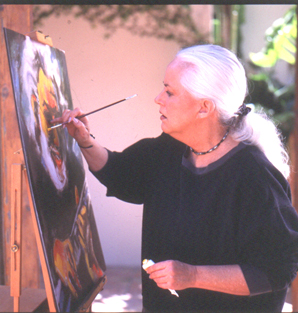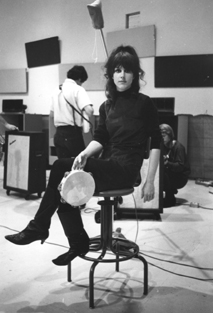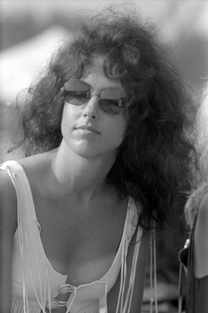Grace Slick: Outside the Looking Glass

Photo by Joel Lipton
Four decades and one year ago this summer, Grace Slick peered out at a half-million fans with bloodshot eyes. It was 6 a.m. Woodstock, N.Y. time. “Morning, people,” she yelped into the microphone. “You’ve seen the heavy groups. Now you’ll see some morning maniac music.”
With that, her group Jefferson Airplane launched into two of its biggest hits, “Somebody to Love” and “White Rabbit.” The band was supposed to take the stage at 9 p.m. the previous evening, but chaos at Woodstock held them back. “Things kept getting screwed up,” recalls Slick. "‘You’re not on now, you’re on in a half-hour,’ then, ‘You’re on now. Oh no, now you’re not.’
“We hung out all night backstage,” she continues. “The speakers weren’t aimed at us, so we heard this muddled barrage of sound and all I saw were other performers’ butts. But hey, we were in our twenties. You talk to people, take drugs, eat grapes, smoke dope. When I said ‘morning maniac music’ it was because I had no idea how we’d sound at that point.”
Today, Slick, 70, paints white rabbits instead of singing about them. In July, a dozen of her works brought in a total of $30,000 at San Diego’s Alexander Salazar Fine Art Gallery. In addition to animals, she also paints fellow ‘60s rock icons: Jimi Hendrix, Janis Joplin, Jim Morrison. Slick is obviously a lot luckier than they are – she survived the drug culture of the ‘60s and ‘70s – they, of course, did not.
Make no mistake, Slick is still relevant – and feisty. Angered by the recent BP oil spill in the Gulf of Mexico, she released “The Edge of Madness,” a song whose proceeds are helping fishermen affected the catastrophe. The tune, which Slick co-wrote with Michelle Mangione, features more than 20 musicians, including Bill Medley of The Righteous Brothers and former Fabulous Thunderbirds guitarist Kid Ramos.
But such musical collaboration is rare these days. Slick pretty much quit the rock scene when she turned 50, shortly after Jefferson Airplane’s reunion in 1989. “I’m not comfortable being an old person on a rock and roll stage,” she says from her home in Malibu, Calif. “Rock, to me, is like sports. You have a certain run and then get out, because it’s no longer applicable.”
When Slick discusses the group she wound down her career with, Jefferson Starship (an evolution of the Airplane), she doesn’t pull punches. "I have trouble singing songs I don’t believe. In the early ‘70s, Jack [Casady] and Jorma [Kaukonen] went to Europe for a year [Hot Tuna] and Paul [Kantner] and I started doing Jefferson Starship. We had an agreement we wouldn’t call it Airplane unless all the original members were playing.
“Paul likes outer space stuff so, I thought, if you want to call it Starship, fine. We did a good first album, Blows Against the Empire 1970. The ‘80s Starship is what I didn’t like. There’s a lot of stuff about the ‘80s that was just dorky, and our music fit right into the dorkiness.”
An example she cites is their chart-topping “Nothing’s Gonna Stop Us Now.” “Now 52 percent of people who get married get divorced,” says Slick, twice divorced herself. “A truck will stop you now. A big semi will really stop you. What do you mean, nothing’s going to stop us? To say that is hubris.”
Slick gleefully confirms the oft-told anecdote that she believes Starship’s “We Built This City” is the worst song ever recorded. “Bernie Taupin wrote it about clubs closing in Los Angeles in the 1970s,” she says. "I thought, ‘OK, but LA isn’t built on rock and roll, but on oranges, oil and the movie industry.’
“People really thought we were singing about San Francisco. Except San Francisco was built on trade and gold. London was built by the Romans. There is no city built on rock because it’s too new. I felt like a dope singing it. But it went to No. 1. That’s pretty pathetic as regards to people’s tastes.”

Slick’s musical career started in 1965 when, after modeling for the San Francisco-based luxury department store I. Magnin, she formed a band with her then-husband Jerry called The Great Society. The group would open for Airplane. As Great Society was breaking up in 1966 – “one of the guys in the group wanted to study sitar in India” – Casady asked Slick to join Airplane. Coincidentally, Airplane’s lead singer, Signe Toley Anderson, was also leaving, to start a family. Slick says that her unequivocal response to Casady was, “You betcha.”
The 1996 Rock and Roll Hall of Fame inductee says she had no idea how big the band’s early hit “Somebody to Love” (co-written with her ex-husband’s brother, Darby and No. 274 on Rolling Stone’s 500 Greatest Songs of All Time) would eventually become. “You understand from playing live, even around San Francisco, what people respond to,” she says. "When I went from Great Society to Airplane I brought that and “White Rabbit” with me because people responded [well]."
She still has fond memories of recording the hits in Studio A at RCA in Los Angeles. “I don’t know whether it was a Tuesday or Thursday, but I do remember being in front of the microphone, then listening to the playback on four big Altec speakers in the control room. I remember thinking, ‘My God, that is amazing – they make it sound like I can really sing.’”
There’s also her recollection of first sighting of The Beatles. "Somebody called and said, ‘Hey, you’ve got to come over and see Ed Sullivan. These guys called The Beatles are on.’ So I went over and they sang “I Wanna Hold Your Hand.” Now these are 20-year-old people singing “I want to hold your hand.” Until they came out with Rubber Soul, I thought they were silly."
However, her reaction to The Rolling Stones was just the opposite. “A short time later, I saw the Stones and thought, ‘OK, that’s the stuff right there.’ When you get onstage, you better own it. Some people are not comfortable with that, so they should be doing something else – dinner theater, maybe. I didn’t imitate Mick Jagger’s style, but I knew from the way he was onstage that that was rock and roll.”
Slick and the Airplane went on to become one of the few groups that played the three big rock festivals of the ‘60s. “Altamont was the negative part of the triad that included Woodstock and Monterey,” says Slick. "People say Altamont was the end of the ‘60s. It was unfortunate, yes [the the Hell’s Angels killed an audience member], but at the time we didn’t think of [the festival] as signaling anything.
“We had used Hell’s Angels [for security] in the parks for free concerts before,” she continues. “Paul and I flew over to talk to Jagger beforehand. ‘Hey, they [Hell’s Angels] are really good,’ we said. Well, in retrospect, not with a lot of alcohol and speed going on all day. The fact that nobody got killed at Woodstock is amazing because that was half a million people. We only had 300,000 at Altamont.”
Of the triad, as Slick calls it, Monterey Pop in 1967 was her favorite. “It was much smaller, more manageable. We had not seen a lot of the other performers yet. I’d heard Jimi Hendrix records, but never seen him live. I had never seen the Mamas and the Papas, Ravi Shankar, The Who. We were all standing on the edges of the stage behind little black curtains. We were just as fascinated as the audience was.”

Photo by Henry Diltz
And she still relishes her near-encounter with President Richard Nixon in the 1970s. As a teen, Slick had attended Finch College, a New York finishing school that Nixon’s daughter Tricia also attended. “It was this dumb place that was easy to get into,” Slick chuckles. “You learn how to be a lady, how to put certain forks correctly around a table setting, how to get a Princeton man. I didn’t really want to go. But you can’t say to your parents, ‘Can I have $15,000 or $20,000 to go screw around in New York?’”
When Nixon was president, Tricia organized a tea at The White House for Finch alumnus and an invite arrived at Slick’s parents’ house under her maiden name, Grace Wing. The invitation also allowed for a guest, so Slick invited political activist Abbie Hoffman. The plan, says Slick, was to spike Nixon’s tea with LSD once inside.
“I had the powder in my pocket and I had a very long pinky finger for cocaine,” she explains. “When talking to Nixon, I was going to put my hand in my pocket, scoop it in my fingernail then wave my hand over his tea cup.”
It never happened. “While in line being checked by guards, one said we couldn’t go in because I was on a security list – FBI or something – apparently because of my lyrics. That turned out to be good for Nixon, bad for us.”
Surprisingly Slick, a rock sex symbol, never thought of herself as spectacular. “Most women are aware of their faults,” she says. “I am not a beautiful woman. I had kinky black hair, which looks odd on a white person, and blonde eyelashes and eyebrows. I had to put on makeup so my eyes matched my hair. I had no tits and, from the knee down, my legs are very, very short. How do you work that? Proportion. You wear boots that come up over your knees so it looks like the lower part is longer.”
For all of those guys who fantasized about her in the ‘60s, Slick’s take on geriatric dating is comically pessimistic. “If you’re taking your clothes off at 70 and some guy has to poke that, you’d better do it in the dark,’” she jokes. “Unfortunately, you can’t put a bag over your whole body. So, no, I don’t have a boyfriend. I wouldn’t want to offend anybody.”
Vintage Grace. Gotta love it.



















